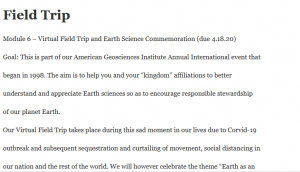Field Trip

Module 6 – Virtual Field Trip and Earth Science Commemoration (due 4.18.20)
Goal: This is part of our American Geosciences Institute Annual International event that
began in 1998. The aim is to help you and your “kingdom” affiliations to better
understand and appreciate Earth sciences so as to encourage responsible stewardship
of our planet Earth.
Our Virtual Field Trip takes place during this sad moment in our lives due to Corvid-19
outbreak and subsequent sequestration and curtailing of movement, social distancing in
our nation and the rest of the world. We will however celebrate the theme “Earth as an
Inspiration” even under these mitigating circumstances.
Activities: A. Non-Education Majors (1) Select any one of the following sites found in Maryland. Write a technical report plus
a video recording of an oral presentation to your peers or “kingdom subjects.” Using your own ingenuity to do research/to locate the following sites:
i. Muddy Creek Falls ii. Swallow Falls iii. Dan’s Rock iv. Sideling Hill v. Crystal Grottoes (only public access cave in Maryland) vi. The Great Falls of the Potomac vii. Soldiers Delight Serpentine Barrens viii. Geologic Walking Tour of Building Stones of Downtown Baltimore ix. Falling Branch (Kilgore) Falls x. Calvert Cliffs xi. Tidewater Maryland xii. Assateague Island (2) Make an oral presentation of the same to your peers or “kingdom subjects.” (3) Record a video of the same and send it to me through Canvas for your credit
towards final grade. (4) Your presentation should capture the 5W’s & H that we started with in Module 1,
i.e., “What, Why, When, Who, Where and How” of Earth Science.
B. Education Majors Write a lesson plan from any one of the following learning activities listed below. The lesson plan should utilize MD STEAM Centric Planning Guide Rubric posted in your Notes Folder and should be submitted together with its video recording of a presentation to a “class” through Canvas for my evaluation towards your course grade.
Learning Activities (i) Painting with Soil (Grade 6-10) (ii) Enliven Data with Art (Grade 4-12) (iii) Shake Alert Earthquake Early Warning (Grade K-12) (iv) What Covers Our Land? (Grade 6-8)
2
(v) Digging into Soil (Grade5-8) (vi) Latitude and Longitude (Grades6-8) (vii) Determining Mineral Reserves (Grades 6-12) (viii) Investigating Rock Types (Grades 5-9) (ix) Its the “Rain,” Man (Grades K-12) (x) Awesome Fossils (Grades K-8) (xi) Making Earth Art with Google Earth (Grades K-12) (xii) Earth and Ancient Architecture (Grades 6-10)
C. Assessments:
(i) Self-Assessment
Ready for
grading?
● Maryland Space Telescope Science Institute, http://www.stsci.edu/
● Explore the universe with advanced space telescopes and ever-growing data archives.
● Satellite data search, analysis and presentations
(ii) How to get a grade: Module Assessment
Graded
Assessments
● Quizzes/assignments/homework/case studies 20% ● Online Earth Science Assignments 20% ● Field Trip Technical Report & Video Recording 10% ● Morgan Mile Community Engagements** 10% ● Mid-Term Exam 20% ● Final Exam 20% ● Total 100%
(a) Virtual Field Trip:-
(1) Is an online Field Trip Technical Report that you will write utilizing the rubric of
technical format provided;
(2) Explaining the tour you took to explore Earth and Space Resources
availed to you depicting some concepts learned in the Course.
(b) (1) ** – This component will be assessed through the submission of a
Minimum of three (3) non-technical reports written on those
activitiesdone outside class learning Modules activities
(2) These non-technical report should depict your professional growth,
promotion of self and MSU in your community and the world.
(3) Reports can be written on what you learned from your conference
attendance, Presidential, School and Departmental Seminars, student
organization participation and other personal engagements in your
home communities, church, etc.
(iii) There are twelve (12) Modules for this Course. Assessment Score for each is:
Module = 100 points
Total points possible = 1200 points
3
(iv) Grading Scale
1. 90% to 100% = A 2. 80% to 89% = B 3. 70% to 79% = C 4. 60% to 69% = D 5. Below 60% = F
(v) Online self-assessments, papers, tests, simulation lab exercises will be added and
grouped into the Modules created in the Canvas Learning Resources. (vi) Assignment deadline will be as assigned on Canvas. An extension will be at the
discretion of the teacher. (vii) Online self-assessments, papers, tests, simulation lab exercises will be added and
grouped into the Canvas Learning Resources. (viii) All communiqué, and submissions of assignments on pdf format, MUST BE DONE
THROUGH MSU CANVAS ONLY. (ix) You should have a Laptop, iPad or PC with a Webcam facility, Acrobat Reader and
Writer so as to facilitate your online exam taking and submissions of assignments. (x) Your exam taking will be monitored through the Webcam video recording of you while
your assignment submissions and class attendance will be monitored through in class activities and the time logged onto Canvas.